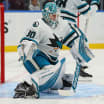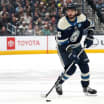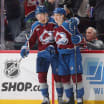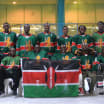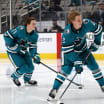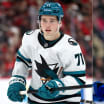For much of August, the world will be riveted to Rio de Janeiro, with the Games of the XXXI Olympiad showcasing competition in events from archery to wrestling that will follow Friday's gala opening ceremony.
It was in 1920 that "ice hockey" made its Olympic debut, so called to differentiate it from the sport played globally on grass, seven nations curiously skating under the umbrella of the Summer Olympics in the Games of the VII Olympiad in Antwerp, Belgium.
Olympic hockey made debut in Summer Games
Team Canada won first gold in Antwerp in 1920

Four years later, ice hockey would be featured in Chamonix, France, in the first Winter Games. But in 1920, with little fanfare and before the opening ceremony in Antwerp, the puck was dropped on a Belgian rink for a tournament that pleased and also puzzled its spectators.
Until then, the International Olympic Committee had balked at even considering ice hockey for its program, citing insufficient European participation as their reason. But in 1920, the IOC rounded up the commitment of host Belgium, France, Switzerland, Sweden and fledgling Czechoslovakia. Germany and Austria were among a handful of countries shut out of Antwerp for their participation in World War I.
Indeed, this was the first Olympics held following the Great War, the 1916 Games scheduled for Berlin having been canceled. War-ravaged Belgium was a symbolic choice to host the 1920 Games, the IOC sending the message that the world was getting back on its feet and the strong-willed, rebuilding host nation reflected the Olympic ideals set down two decades earlier by French Baron Pierre de Coubertin, founder of the modern Games.
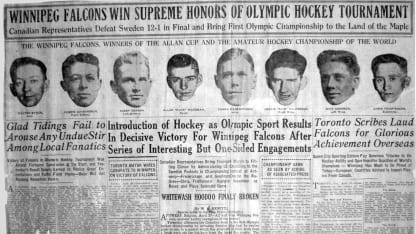
This would be the first Olympics at which the flag with five interlocking rings was raised, and at which the Olympic Oath was spoken.
So it was on this historic Antwerp stage that ice hockey would take its first bow in the Olympics. With figure skating, it essentially was packaged inside the Summer Games, but took place in April.
In his 2009 book "Canada's Olympic Hockey History: 1920-2010," author Andrew Podnieks points out another reason why ice hockey was granted 1920 entry into the IOC's private club: Managers of Antwerp's Le Palais de Glace insisted the sport be included on the program if genteel figure skating was to use the rink.
The political wrangling took seemingly forever; the five European participants, as well as Canada and the United States, did not learn until two months before the Games that ice hockey would be on the program.
And it surely wouldn't be Olympic hockey of the variety enjoyed today, with the sport having since evolved from its earliest, lopsided days to ultimately include the fiercely competitive participation by NHL talent and the world's best female players.
Canada would select a club team to represent the country in Belgium. The Winnipeg Falcons had just won the Allan Cup, a title emblematic of amateur-team superiority in Canada, by defeating the Fort William Maple Leafs 9-1 and 7-2 in the semifinal round, then beating the University of Toronto varsity team 8-3 and 3-2 in a two-game, total-goals championship final.
The weeklong ocean journey from Saint John, New Brunswick, to Liverpool, England would cost about $10,000, paid for by Allan Cup receipts and donations from the government of Manitoba and the city of Winnipeg.
It was an uneventful crossing of the Atlantic aboard the S.S. Melita for Canada's eight-man team, which had seven players of Icelandic extraction and six members who were returning to Europe after having fought in the war.
The trip's only mishap, Podnieks wrote, was team captain Frank Fredrickson tumbling out of his bunk and banging his head.
"The ship's carpenter," he wrote, "carved two dozen sticks from 'rough' wood the team had obtained in Montreal; these were the only sticks the Falcons would be using in the Olympics."
A second travel leg then took the team from Dover to Ostend, Belgium, for the Games.
Canada was considered the huge favorite in a format that saw six players and a free-ranging rover play two 20-minute halves, substitutions not permitted. An injury would require the opponent to remove a player to keep the sides even, at least in number.
Teams played the "Bergvall" system of elimination, a curious knockout format to set up the medal-round games, with "Canadian rules" in place. The regulations had been written by highly respected Falcons manager and hockey pioneer William Hewitt, the father of future hockey broadcast legend Foster Hewitt, and featured four goal judges among a host of other off-ice officials.
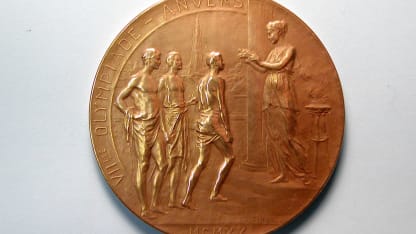
Matches were played on a surface that was roughly 170 feet long by 65 feet wide but appeared smaller with seven players per side, with well-heeled spectators eating and drinking extravagantly at rinkside while an orchestra played throughout.
Canada wasn't exactly challenged in this first tournament, defeating Czechoslovakia 15-0 in its first game. The United States, an all-star team assembled for the event, was a much tougher test in the Falcons' second game, but they, too, came up on the short end of a 2-0 score.
Canada then defeated Sweden 12-1 in the gold-medal final, the U.S. victorious against Sweden 7-0 and Czechoslovakia 16-0 in the silver-medal tournament to finish second, the Czechs winning the bronze with a 1-0 victory against Sweden.
Fredrickson, after his steamship tumble, scored 12 goals in three games. Haldor "Slim" Halderson, who with his Falcons captain was the only other member of this team to make it to the NHL, scored nine times, while goalie Wally Byron gave up one goal, and apparently was aghast to have surrendered it.
The triumphant Canadians were feted generously following their victory, bouncing from one banquet to the next, guests of honor of military and government leaders. The respect shown to them in Belgium was remarkable; their ship was the only one allowed to leave from Havre's strike-locked port for their 11-day transatlantic return.
Homecoming receptions were stunning in scope. The Falcons celebrated in Montreal and Toronto before Winnipeg rolled out a red carpet that seemingly stretched through the city limits for the conquering heroes.
Canadian teams would be crowned Winter Olympic hockey champion again in 1924, 1928 and 1932 before being stunned for the gold by Great Britain at Garmisch-Partenkirchen, Germany, in 1936. The nation would bounce back to win gold in 1948 and 1952 - the 1940 and 1944 Games were canceled because of World War II - before enduring a 50-year drought - 12 Olympics - until its return to the gold-medal podium at Salt Lake City in 2002, with gold medals to come in 2010 and 2014.
All except 1920's historic curtain-raising tournament have been played under the Winter Olympic banner, as will every one in the future.
Which certainly is just as well this year, Rio de Janeiro's five-ring headaches plentiful enough without having to build an ice rink on steamy Copacabana Beach.





